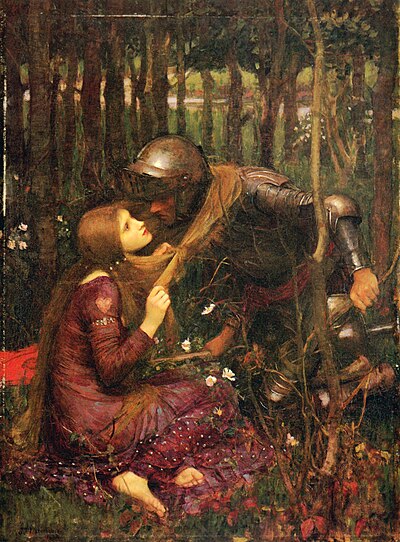September 14, 2021
|
O what can ail thee, knight-at-arms, |
Notes & Commentary
- ↑ Written in 1819, this ballad tells the story of haggard knight and his beloved: a fairy maiden who bewitches him then abandons him to a desolate landscape. Its deceptively simple ballad form conveys an air of mystery and barrenness in its four-line stanzas and shortened last line (Inglis 1969, p. 116). I can’t help but think of Odysseus and Circe, as the latter seduces and keeps Odysseus and his crew on her island for a year, unable to continue their journey home, but also “in thrall”—unable to be men and continue their violence in the outside world. Like Circe, the woman here has a power—whether it’s supernatural or just a product of her beauty and men’s lust is uncertain—and seems to represent the archetype of the fatal woman (Inglis 1969, p. 117).
Bibliography
- Battenhouse, Henry M. (1958). English Romantic Writers. New York: Barron’s Educational Series, Inc.
- Bloom, Harold (2001). John Keats. Bloom’s Major Poets. Broomall, PA: Chelsea House.
- Frye, Paul H. (1987). "Voices in the Leaves: the 'Ode on a Grecian Urn'". In Bloom, Harold. The Odes of Keats. New York: Chelsea House. pp. 83–92.
- Garrett, John (1987). Selected Poems of John Keats. MacMillan Master Guides. London: MacMillan.
- Greenblatt, Stephen, ed. (2018). The Norton Anthology of English Literature. The Major Authors. 2 (Tenth ed.). New York: W. W. Norton.
- Inglis, Fred (1969). Keats. Arco Literary Critiques. New York: Arco.
- Nersessian, Anahid (2021). Keats’s Odes: A Lover’s Discourse. Chicago: The University of Chicago Press.
- Vendler, Helen (1983). The Odes of John Keats. Cambridge, MA: The Belknap Press.
- Wasserman, Earl (1964). "The Ode on a Grecian Urn". In Bate, Walter Jackson. Keats: A Collection of Critical Essays. Twentieth Century Views. Englewood Cliffs, NJ: Prentice-Hall. pp. 113–141.
